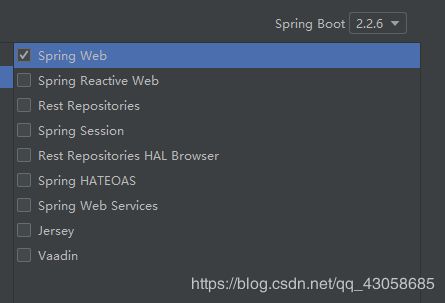【SpringBoot】如何优雅的实现跨服务器上传文件
项目完整代码链接:代码链接
文章目录
- 一、创建项目
- 1.1 上传文件的项目
- 1.2 创建fileuploadserver 保存文件服务器
- 二、编写服务器接收文件上传代码
- 三、分析存在问题以及解决办法
- 3.1 问题分析
- 3.2 修改项目fileupload的配置
- 3.3 创建fileuploadserver1 项目
- 3.4 编写服务器接收文件上传代码
- 3.5 编写文件服务器接收代码
- 3.6 效果展示
一、创建项目
- springboot:2.2.6
- JDK:1.8
由于资源有限,就用不同端口表示不同服务器了。
1.1 上传文件的项目
首先idea快速搭建工具创建一个springboot项目,名字为fileupload,作为上传文件的服务端。
选择spring web模块即可
spring.servlet.multipart.enabled=true
spring.servlet.multipart.max-file-size=30MB
spring.servlet.multipart.max-request-size=30MB
#文件保存的url,末尾的 / 别漏了
file.upload.path=http://localhost:8888/fileuploadserver/uploads/
添加坐标依赖
跨服器上传所需要的jar包坐标
<dependency>
<groupId>com.sun.jerseygroupId>
<artifactId>jersey-coreartifactId>
<version>1.18.1version>
dependency>
<dependency>
<groupId>com.sun.jerseygroupId>
<artifactId>jersey-clientartifactId>
<version>1.18.1version>
dependency>
1.2 创建fileuploadserver 保存文件服务器
创建一个jeex项目,项目名字为fileuploadserver,什么都不需要配置。然后再webapp目录下创建一个uploads文件夹,与上面项目设置的文件保存地址一直,然后配置好tomcat环境启动即可。记得把web.xml文件里面的配置信息删掉
如下图所示
记得改下Http和JMX的端口,免得和其他项目冲突了。
二、编写服务器接收文件上传代码
编写一个controller类,用与处理文件上传
MultipartFile类用来保存上传的文件数据
package cn.jxj4869.fileupload.controller;
import com.sun.jersey.api.client.Client;
import com.sun.jersey.api.client.WebResource;
import org.springframework.beans.factory.annotation.Value;
import org.springframework.stereotype.Controller;
import org.springframework.web.bind.annotation.RequestMapping;
import org.springframework.web.bind.annotation.RequestParam;
import org.springframework.web.bind.annotation.ResponseBody;
import org.springframework.web.multipart.MultipartFile;
import java.io.IOException;
import java.util.UUID;
@Controller
public class FileController {
@Value("${file.upload.path}")
private String path;
@RequestMapping("/fileupload/method1")
@ResponseBody
private String method1(@RequestParam("upload") MultipartFile upload) throws IOException {
System.out.println("跨服务器上传文件上传");
String filename = upload.getOriginalFilename();
// 把文件的名称设置唯一值,uuid
String uuid = UUID.randomUUID().toString().replace("-", "");
filename = uuid + "_" + filename;
// 创建客户端的对象
Client client = Client.create();
// 和图片服务器进行连接
WebResource webResource = client.resource(path + filename);
webResource.put(upload.getBytes());
return "success";
}
}
前端代码
放在/resources/static/目录下
<html lang="en">
<head>
<meta charset="UTF-8">
<title>fileuploadtitle>
head>
<body>
<h3>method1h3>
<form method="post" enctype="multipart/form-data" action="fileupload/method1">
<input type="file" name="upload">
<br>
<input type="submit">
form>
body>
html>
上传效果如下
三、分析存在问题以及解决办法
3.1 问题分析
正如上面写的,只要我们关联了服务器地址之后就可以直接通过put方法把文件上传上去,这无疑是非常危险的行为。因为在上传过程中并没有进行用户校验,那么如果被人知道了服务器保存图片的路径,甚至不需要知道准确路径,只要知道服务器ip地址就够了,那么他就可以通过put方法无限量的进行服务器上传。
根据apache官方在2017公布的一个漏洞,如果开启了put方法,那么就可以任意写写入文件到服务器。但是如果禁用了put方法,那么又有导致一些需要put方法的业务无法使用。
一个解决办法就是修改tomcat的配置。修改在tomcat的/conf目录下的web.xml。找到下面这段
把readonly设置成true。这样就无法通过put往服务器中写入文件了。
<servlet>
<servlet-name>defaultservlet-name>
<servlet-class>org.apache.catalina.servlets.DefaultServletservlet-class>
<init-param>
<param-name>readonlyparam-name>
<param-value>trueparam-value>
init-param>
servlet>
但是这样一来,我们就无法通过上述方法来进行跨服务器上传了,因为文件服务器已经禁止了通过put方法写入文件。那么这种情况应该怎么办呢?
有一种思路就是把服务器接收到的文件上传请求,通过HttpPost再把上传的文件信息发送到文件服务器。由文件服务器自己处理是否接收保存文件。
3.2 修改项目fileupload的配置
添加HttpPost的相关坐标依赖
org.apache.httpcomponents
httpclient
4.3.6
org.apache.httpcomponents
httpmime
4.5
org.apache.httpcomponents
httpcore
4.4.1
添加配置:
application.properties
file.upload.path1=http://localhost:8888/fileupload/
3.3 创建fileuploadserver1 项目
创建一个springboot项目,选择如**fileload**项目一样。
创建好之后在/resources/目录下创建一个uploads文件夹,用作保存上传文件的位置。(也可以根据自己实际需要,更改文件保存的位置)
配置相关参数
# 文件上传位置 这里是路径是相对于项目而言,可以根据实际情况更改
file.upload.save-path=/uploads/
#文件访问路径
file.upload.url=/uploads/**
server.port=8888
#文件大小设置
spring.servlet.multipart.enabled=true
spring.servlet.multipart.max-file-size=30MB
spring.servlet.multipart.max-request-size=100MB
3.4 编写服务器接收文件上传代码
用数组的形式接收MultipartFile参数,实现多文件上传。
把上传的文件用MultipartEntityBuilder打包好之后,再用HttpPost发送到文件服务器。这里最好需要了解一些HttpPost用法。
package cn.jxj4869.fileupload.controller;
import com.sun.jersey.api.client.Client;
import com.sun.jersey.api.client.WebResource;
import org.apache.http.HttpEntity;
import org.apache.http.client.methods.CloseableHttpResponse;
import org.apache.http.client.methods.HttpPost;
import org.apache.http.entity.ContentType;
import org.apache.http.entity.mime.MultipartEntityBuilder;
import org.apache.http.impl.client.CloseableHttpClient;
import org.apache.http.impl.client.HttpClients;
import org.springframework.beans.factory.annotation.Value;
import org.springframework.stereotype.Controller;
import org.springframework.web.bind.annotation.RequestMapping;
import org.springframework.web.bind.annotation.RequestParam;
import org.springframework.web.bind.annotation.ResponseBody;
import org.springframework.web.multipart.MultipartFile;
import java.io.IOException;
import java.util.UUID;
@Controller
public class FileController {
@Value("${file.upload.path1}")
private String path1;
@RequestMapping("/fileupload/method2")
@ResponseBody
private String method2(@RequestParam("upload") MultipartFile[] uploads) throws IOException {
System.out.println("跨服务器上传文件上传");
CloseableHttpClient httpClient = HttpClients.createDefault();
HttpPost httpPost = new HttpPost(path1);
MultipartEntityBuilder builder = MultipartEntityBuilder.create();
for (MultipartFile upload : uploads) {
String filename = upload.getOriginalFilename();
builder.addBinaryBody("upload", upload.getBytes(), ContentType.MULTIPART_FORM_DATA, filename);
}
try {
HttpEntity entity = builder.build();
httpPost.setEntity(entity);
CloseableHttpResponse response = httpClient.execute(httpPost);
System.out.println(response.getStatusLine().getStatusCode());
String s = response.getEntity().toString();
System.out.println(s);
} catch (Exception e) {
} finally {
httpClient.close();
}
return "success";
}
}
前端部分的代码
<html lang="en">
<head>
<meta charset="UTF-8">
<title>fileuploadtitle>
head>
<body>
<h3>method2h3>
<form method="post" enctype="multipart/form-data" action="fileupload/method2">
<input type="file" name="upload"><br><br>
<input type="file" name="upload"><br><br>
<input type="file" name="upload">
<br><br>
<input type="submit">
form>
body>
html>
3.5 编写文件服务器接收代码
接收的Controller
ResourceUtils.getURL("classpath:") 获取当前项目所在的路径,最好别存在中文,可能会出错
package cn.jxj4869.fileuploadserver1.controller;
import com.sun.javafx.scene.shape.PathUtils;
import org.springframework.beans.factory.annotation.Value;
import org.springframework.boot.system.ApplicationHome;
import org.springframework.stereotype.Controller;
import org.springframework.util.ResourceUtils;
import org.springframework.web.bind.annotation.PostMapping;
import org.springframework.web.bind.annotation.RequestParam;
import org.springframework.web.bind.annotation.ResponseBody;
import org.springframework.web.multipart.MultipartFile;
import javax.servlet.http.HttpServletRequest;
import java.io.File;
import java.io.IOException;
import java.util.UUID;
@Controller
public class FileController {
@Value("${file.upload.save-path}")
private String savePath;
@PostMapping("/fileupload")
@ResponseBody
private String fileupload(HttpServletRequest request, @RequestParam("upload")MultipartFile[] uploads) throws IOException {
System.out.println("文件上传");
String path= ResourceUtils.getURL("classpath:").getPath()+savePath;
File file = new File(path);
if (!file.exists()) {
file.mkdir();
}
for (MultipartFile upload : uploads) {
String filename = upload.getOriginalFilename();
String uuid = UUID.randomUUID().toString().replace("-", "");
filename=uuid+"_"+filename;
upload.transferTo(new File(path,filename));
}
return "success";
}
}
编写配置类
package cn.jxj4869.fileuploadserver1.config;
import org.springframework.beans.factory.annotation.Value;
import org.springframework.cglib.core.WeakCacheKey;
import org.springframework.context.annotation.Configuration;
import org.springframework.web.servlet.config.annotation.ResourceHandlerRegistry;
import org.springframework.web.servlet.config.annotation.WebMvcConfigurer;
@Configuration
public class MySpringMvcConfig implements WebMvcConfigurer {
@Value("${file.upload.save-path}")
private String savePath;
@Value("${file.upload.url}")
private String url;
@Override
public void addResourceHandlers(ResourceHandlerRegistry registry) {
registry.addResourceHandler(url).addResourceLocations("classpath:"+savePath);
}
}
3.6 效果展示
如果对您有帮助,麻烦三连走一波














